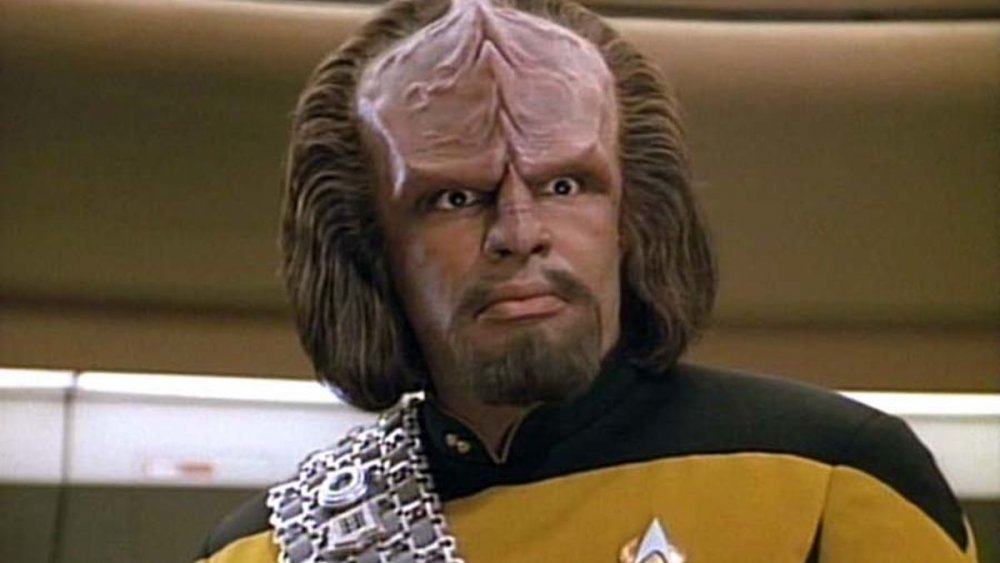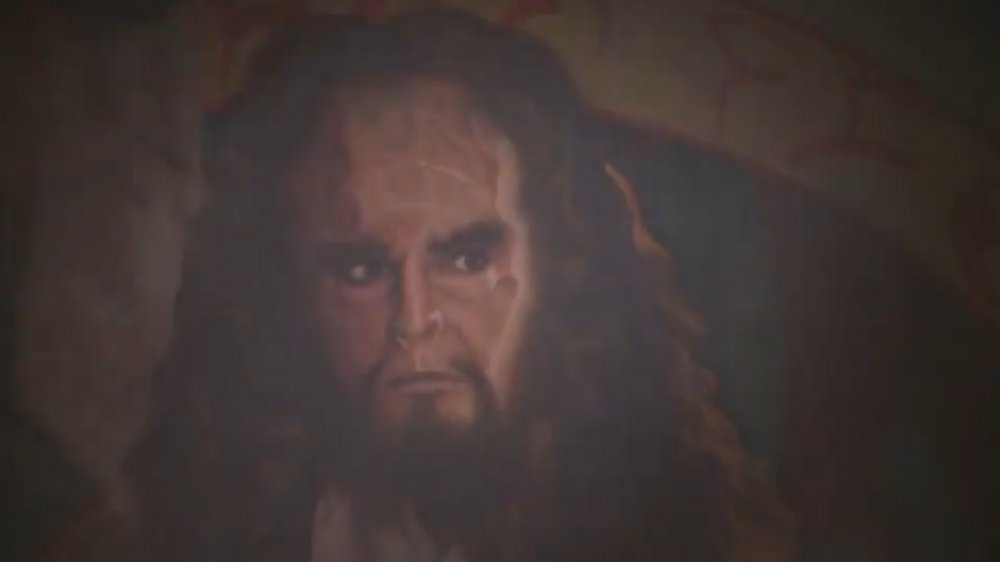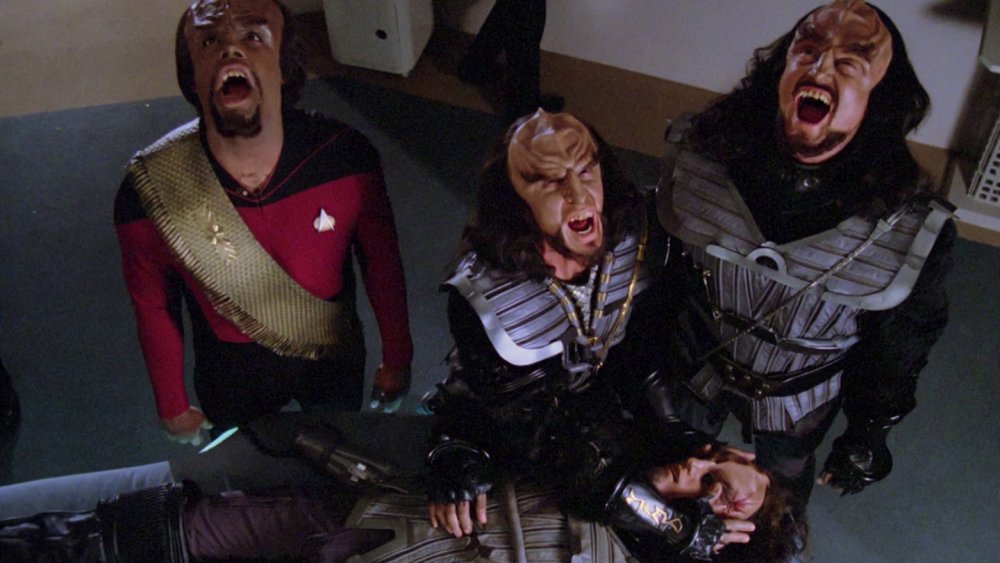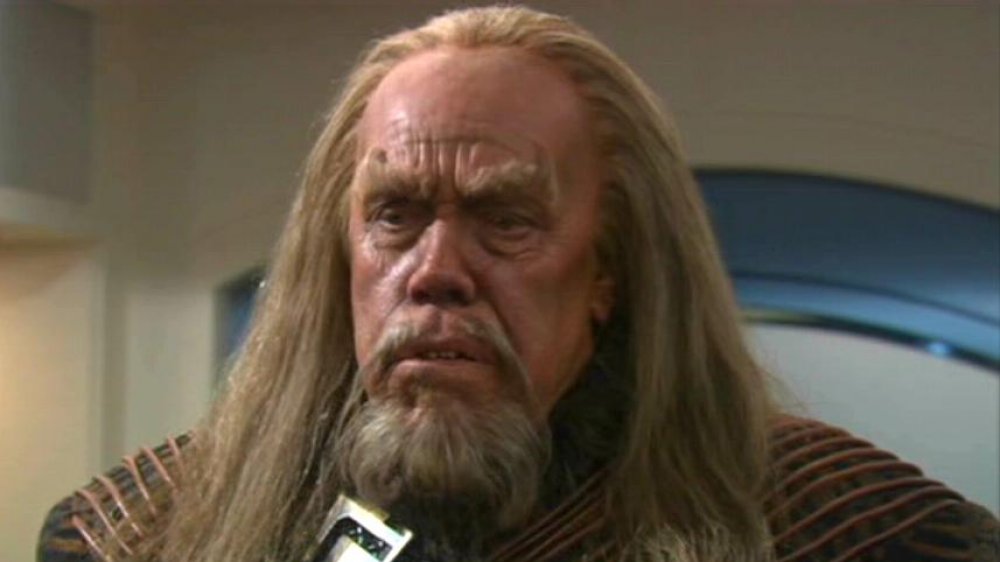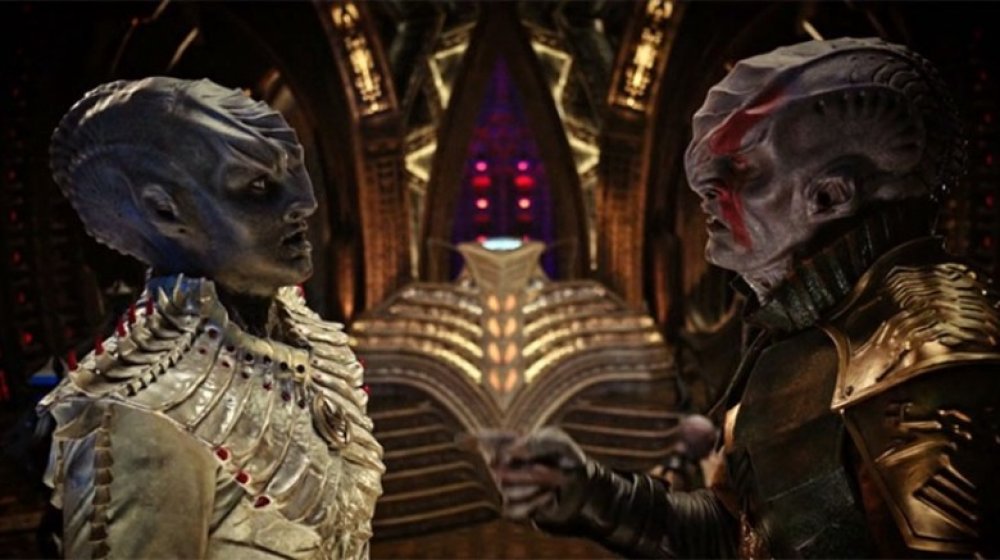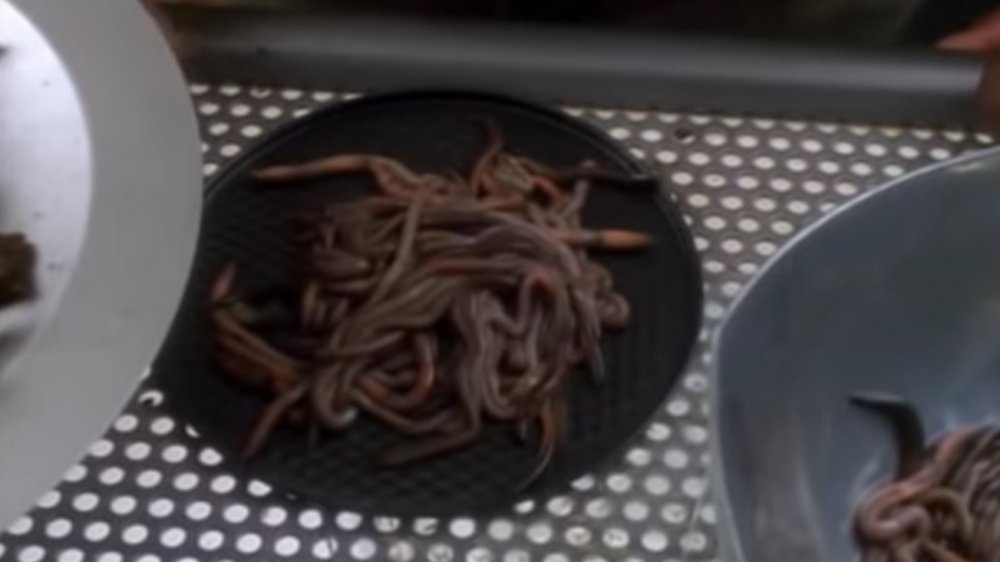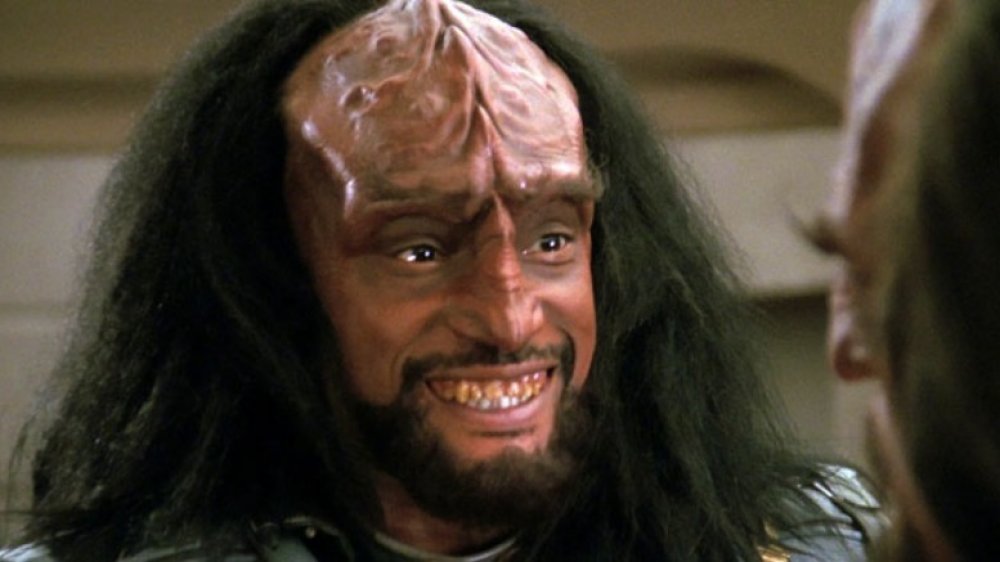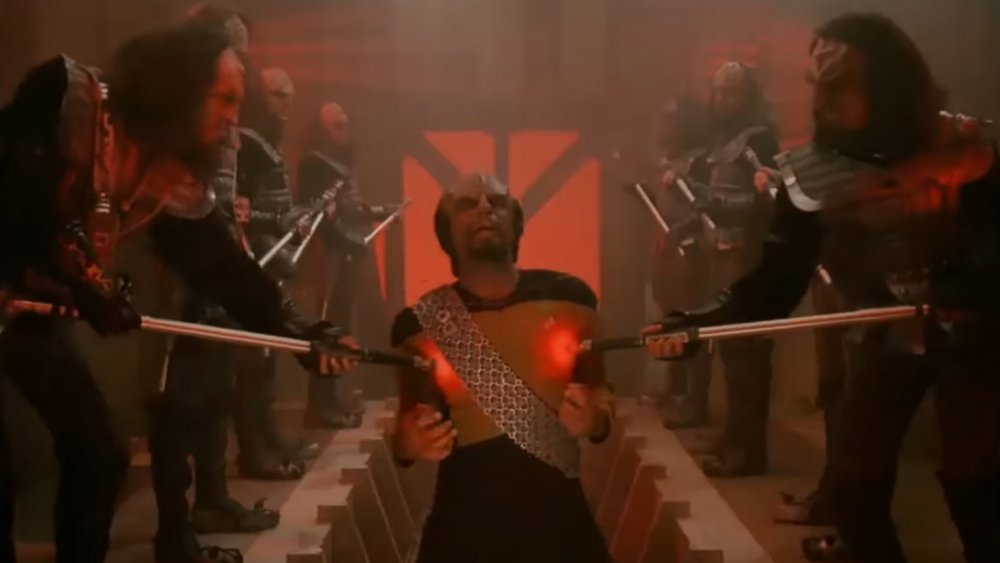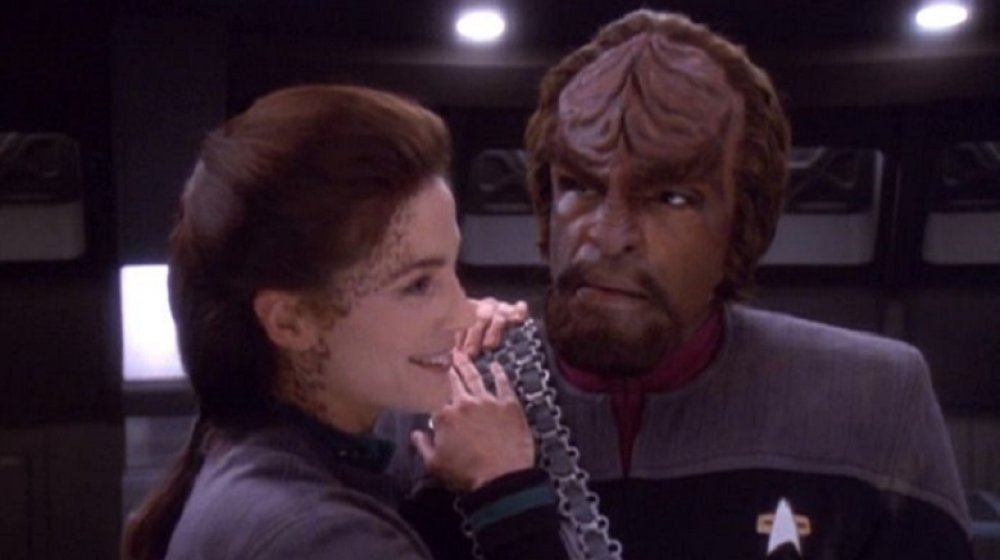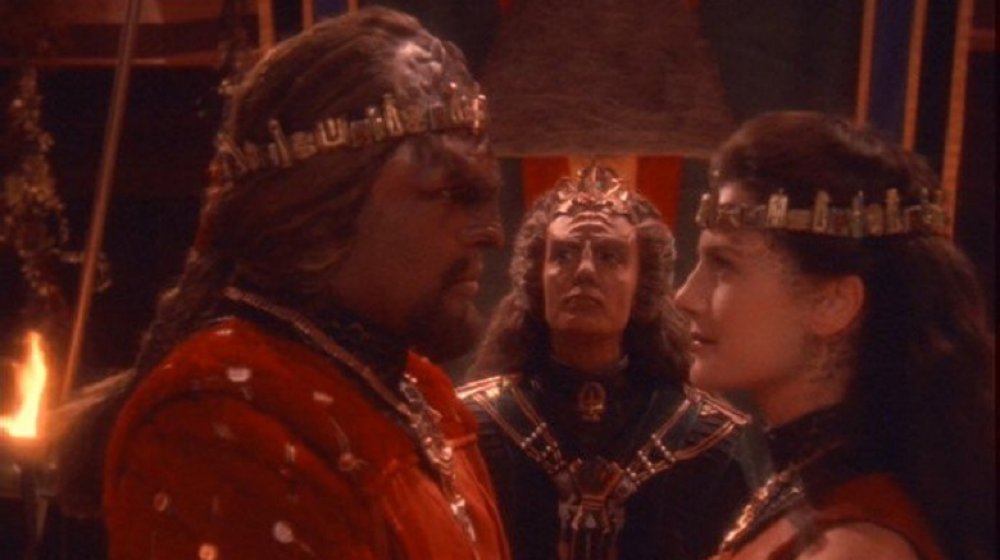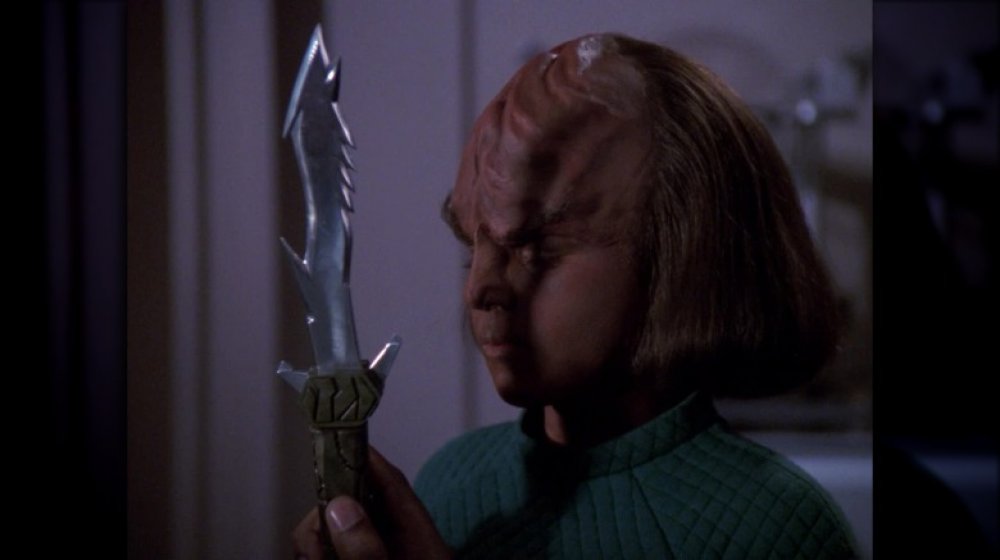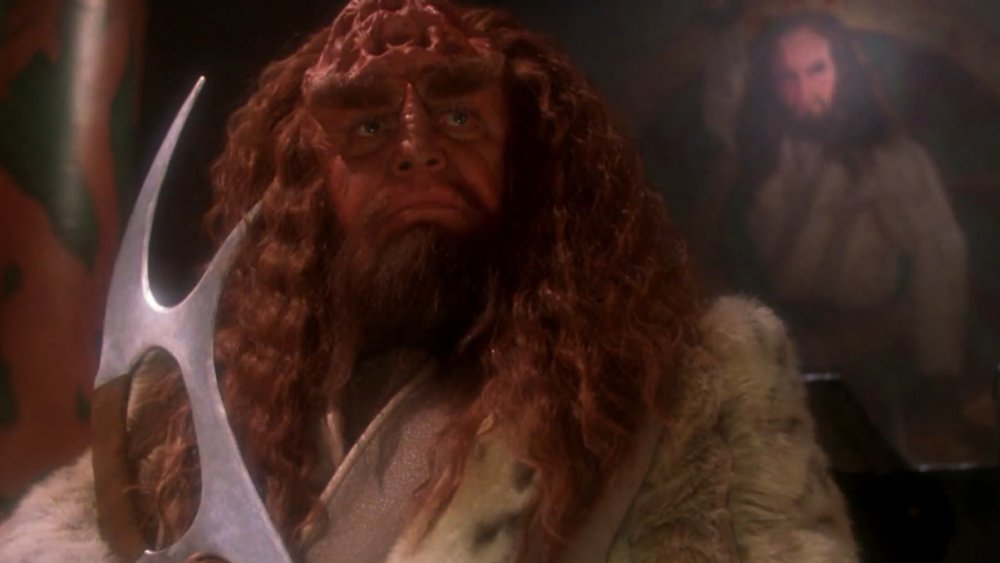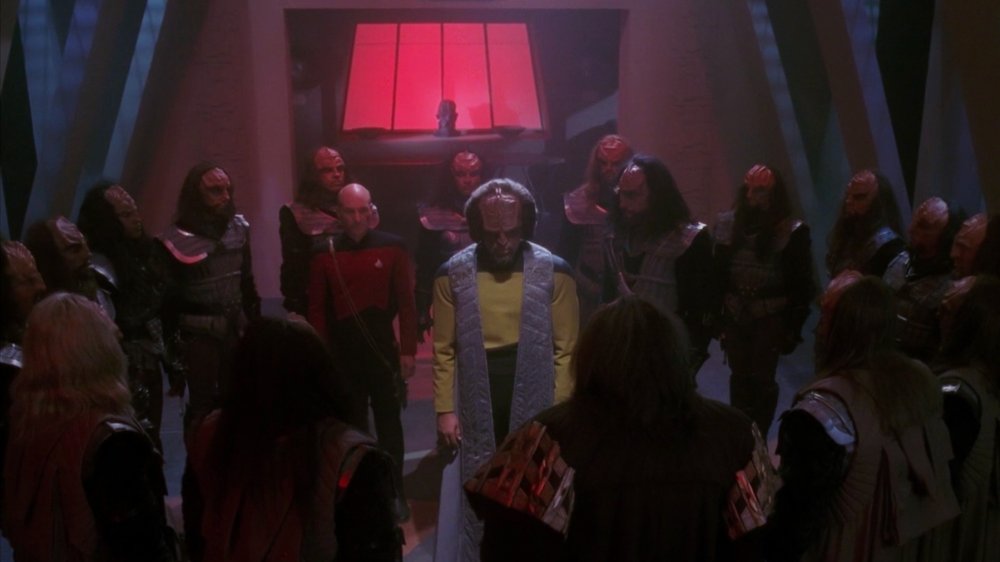The Messed-Up Truth About Star Trek's Klingons
Klingons, Star Trek's iconic warrior race, are easily the franchise's most recognizable aliens without pointy ears. These Federation frenemies live for battle, cutting down their foes, headbutting their friends, and hoping above all for glorious deaths, worthy of song and Sto-vo-kor. Unlike those backstabbing Romulans or sniveling Ferengi, the Klingon heart is filled with honor, bloodlust, and joy. Warriors fill any room they enter, their voices proud, their calls for bloodwine loud, and their d'k tahgs ever-ready for the next p'takh foolish enough to challenge them.
At least, that's how it's supposed to work, but as with many things, there's more to the Alpha Quadrant's deadliest dramatists than meets the eye. They're warriors to be crossed at one's peril to be sure, but they're hardly one-dimensional space barbarians drinking and stabbing their way through the cosmos. The devotees of Kahless are much more nuanced than that, so let's take a deep dive into the messed up truth about Star Trek's Klingons.
The Klingons killed their gods
The Klingons' creation myth is just as violent as you'd expect. According to Memory Alpha, in the distant past, the gods created the first-ever Klingon, Kortar, his heart forged from fire and steel. Kortar, however, was lonely, so the gods made the first Klingon woman to be his mate. The gods were apparently a bit too presumptuous with their children, though, because Kortar and his mate slew their creators for being "more trouble than they were worth" and burned the heavens for good measure.
With the gods out of the way, Klingon religion pretty much revolves around Kahless the Unforgettable, who, in the ninth century AD (by the human calendar), defeated the tyrant Molor and started the Klingon Empire. It was Kahless who forged the first bat'leth (that double-sided Klingon weapon) and taught his people the ways of honor, which is pretty important since honor is everything when it comes to the Klingon afterlife.
Those who die with honor will be welcomed into the gates of Sto-vo-kor by Kahless himself. A glorious death in battle is the ideal way to achieve this, but if one dies without honor through no fault of their own, such as by falling to the ambush of a coward, they may still be admitted to Sto-vo-kor if others dedicate a great battle to them. The dishonored dead, on the other hand, are ferried down the River of Blood to Gre'thor.
Klingons are hard to kill ... supposedly
Klingons aren't just burly people with fabulous foreheads, and one look at their internal anatomy proves it. Per Memory Alpha, their bodies can keep on going despite wound after wound due to brak'lul, which is the Klingon term for their innards' ubiquitous redundancy. They possess three lungs, two stomachs, two livers, a generous helping of ribs, and a big, strong eight-chambered heart, among other things. As pointed out by The Wrap, a shot of a Klingon urinating in an episode of Star Trek: Discovery shows two streams of urine hitting an unlucky wall. Make of that what you will.
Having two or more of just about everything means Klingons will survive injuries that would be fatal to weaker species ... or so it's stated. It hasn't always played out that way in the franchise, though. Our noble protagonists need to survive to spread the virtues of humanity another day, so plenty of Klingons, even important characters, have been depicted dying improbably quickly from mere stab wounds. Gowron, who was surely voted "Best War Face" in Klingon high school, fell to a pair of broken bat'leth tips courtesy of Worf, and Duras didn't fare much better, either.
They lost their ridges in an experiment gone wrong
Klingons are known for their fierce-looking ridged foreheads, but that wasn't always the case. In The Original Series, they pretty much looked like humans, but when they showed up in Star Trek: The Motion Picture, their foreheads had become considerably fancier. According to Ex Astris Scientia, Gene Roddenberry's word on the subject was that the Klingons were always supposed to have ridged foreheads — the makeup technology (and budget) just wasn't there back in the '60s.
In other words, viewers of The Original Series just needed to use their imaginations, but who feels like doing that? So the Klingons' smooth-headed appearance was canonized in the Deep Space Nine episode "Trials and Tribble-ations,” in which several members of the DS9 cast find themselves hurled back in time to the TOS era. They're surprised by the appearance of the 23rd-century Klingons and ask Worf about it, to which he simply replies, "We do not discuss it with outsiders."
A full explanation finally came in Star Trek: Enterprise. In Enterprise, the Klingons of the 22nd century looked just as they did in the 24th century, until a Klingon scientist experimented with genetic material obtained from augmented humans (think Khan) in order to create better warriors. One of the subjects was infected with a normally harmless flu which then mutated and became a deadly plague. A cure was found, but tons of Klingons were left with smooth foreheads, a trait which would remain for several generations.
There's no good explanation for their appearance in Discovery
The Klingons in Star Trek: Discovery went where no Klingon has gone before in terms of appearance. Not only were their foreheads ridged, but so was practically every surface on their bodies. Their long, flowing hair was gone, and some Klingons sported far more elongated skulls than had ever been portrayed previously. This is a bit of a problem when you consider that Discovery is part of the main Star Trek series timeline and takes place only around a decade before The Original Series.
As detailed by Ex Astris Scientia, the appearance change was due to the creators' desire to visually reimagine the Klingons. They even dialed it back in season two, such as with L'Rell, who had an elongated, hairless skull in the first season but suddenly had a more round head with plenty of hair and more Klingon-typical forehead ridges in the second. All the same, in-canon explanations for the Klingons' Discovery appearance don't come easily. Prominent ideas include that the Discovery look is but one in a series of mutations throughout history, that the Discovery Klingons are an otherwise isolated subspecies, or that viewers just have to imagine that the Klingons always looked like they do in Discovery, but one thing or another from Discovery and the other series can invalidate all of these notions. Maybe the Klingons synthesized a ridge-promoting medication and started taking way too much of it?
Klingon cuisine is not for the weak of stomach
Klingons love three F-words — fighting, food, and ... well, you know. But let's talk more about the food. Klingons have just as much of a culinary tradition as any culture, but their cuisine would turn the stomachs of most humans. Random tentacles and animal organs are a staple, and they like their food raw. Prominent examples of Klingon dishes include heart of targ, bregit lung, pipius claw, and rokeg blood pie, and don't forget to wash it all down with a hearty cup of bloodwine.
Of course, no discussion of Klingon food would be complete without mentioning gagh, aka serpent worms. According to the Star Trek Database, gagh is a delicacy best served live, though it can be stewed. There are over 50 different kinds of gagh, set apart by what kind of worm is used and how it is (or isn't) prepared. There's squirming gagh, jumping gagh, and gagh with feet, to name a few. If all that variety isn't enough for you, then there's also the similarly named (in that both seem to represent sounds of disgust) racht, aka big, earthworm-looking fare. Racht should be eaten live as well.
First impressions are everything
First impressions often have lasting effects, and that principle holds true for Klingons as well, albeit with their own predictably warlike spin. As told by Memory Alpha, in 2016, decades before humans had achieved warp drive, a Vulcan ship entered Klingon space and was promptly destroyed by the territorial warriors. Since, according to Sarek, "Vulcans don't make the same mistake twice," the normally peaceful space elves opened fire on the Klingons, immediately and without provocation, at every encounter thereafter, and as it turns out, that's a great way to say hello. Rather than starting a Vulcan-Klingon war, shooting at the Klingons earned the Vulcans their respect, and diplomatic relations were established.
On a related note, punching a Klingon is perfectly acceptable (although that's a door that presumably swings both ways). As shown in Deep Space Nine, good Klingon manners also include getting right up in another's face and speaking loudly. Do not, however, strike your new acquaintance with the back of your hand, as that's how you challenge a Klingon to a duel to the death.
The Klingon rite of passage is insane
Young Klingons are expected to become warriors before they're old enough to say "warrior," and there are important rituals to be performed along the way. According to Memory Alpha, first comes the Rite of Ascension. In this short, to-the-point ceremony, a Klingon child lights a kor'tova candle, which signifies the fire burning in the heart of a warrior, as a declaration that the fire is now in their heart as well.
This heartwarming moment will lead to a symphony of screams down the road. Within ten years, the Second Rite of Ascension must be performed for one to truly become a warrior, and there's a special chamber for this one. Inside is a gauntlet of eight Klingon warriors wielding painstiks, which are just what they sound like. These painstiks aren't just fancy tasers. Chief O'Brien once recalled seeing a two-ton animal's head explode after repeated hits. Fun times.
To complete the Second Rite of Ascension, an initiate must advance through the gauntlet, being zapped by two painstiks at a time, all while the aspiring warrior shouts his deepest, most personal feelings for all to hear, for doing so under torture is a profound display of Klingon strength. Those undergoing the rite can scream, stumble, and fall all they like, as long as they make it through. If they do, they leave the ascension chamber as a warrior.
Klingons like it rough
Klingons are warriors everywhere, and the bedroom is no exception. Simply put, they like the kind of lovemaking that registers on seismographs. Now, that's not to say that they're clueless in the arts of seduction and foreplay. Just don't expect any of that to be gentle or subtle, either. According to Worf, a bloodcurdling scream (but not a roar) is a great way to woo a love interest. Once the encounter has started, a suitor might choose to recite love poetry while ducking hurled heavy objects. Per Memory Alpha, the act can also begin with the lovers clutching each other's hands hard enough to draw blood.
All that gentle foreplay can only lead to one thing ... broken bones. Klingon sex commonly ends with both participants sporting multiple fractures, and breaking a collarbone on a couple's wedding night is seen as a sign that the marriage is blessed. When Quark, possibly the first-ever Ferengi to make love to a Klingon, emerged from his encounter, he'd suffered a compound fracture to his right arm, as well as broken ribs, and was generally battered all over. In a similar vein, when Riker temporarily served aboard a Klingon ship, several of his new crewmates wondered how well he'd endure intimacy with the women on board.
Klingon weddings are crazy
Love conquers all, even the Klingon heart. Many warriors face that special time — when they've fallen for a certain someone, when they've proudly tossed a freshly killed animal onto their lover's table, when they've tasted each other's blood and broken each other's bones. It is time, then, to take the oath.
As detailed by Memory Alpha, a traditional Klingon wedding involves just as much ritual as any other sacred rite. For the marriage to even take place, the lady of the groom's house must approve the bride, who'll have to do basically everything except jump through hoops to earn the lady's blessing. She must become well-versed in the history of the women of her prospective husband's house, and she'll have to be able to perform several rituals flawlessly. Meanwhile, the groom and his friends endure the Kal'Hyah, during which they spend four days in a cave fasting, bleeding, suffering, and singing. It's not your typical bachelor party.
At the wedding ceremony itself, the happy couple are welcomed by the beats of warriors' drums as the lady of the groom's house tells the Klingon tale of creation. The Tawi'Yan (essentially the best man) hands bat'leths to the bride and groom, who then engage in mock battle, representing the clash of two Klingon hearts. Finally, vows are said, and then the guests attack the newlyweds with ceremonial sticks.
Kill your father for honor
You might have noticed that honor is everything for Klingons, especially where the manner of one's death is concerned. Life's a p'takh, however, and sometimes, through no fault of his own, a Klingon is left unable to act as a warrior any longer. When there's no more honor to be had, only the shame of burdening one's family, it is time for the Hegh'bat.
Per Memory Alpha, the Hegh'bat entails the family of a Klingon who's been incapacitated (by a paralyzing injury, for example) assisting him in ritual suicide. Ideally, the injured warrior's oldest son helps, and his role is to hand his father a blade. The father plunges it into his heart, after which the son removes the weapon and wipes the blood on his sleeve. The Hegh'bat isn't the only example of a son killing his father for reasons of honor, either. To be captured alive in battle is a great dishonor, and warriors who suffer this fate may hope that their sons will kill him should they ever meet again, as L'Kor hoped in the Next Generation episode "Birthright, Part II."
They cloned their messiah
According to the Star Trek Database, Klingon lore holds that late in his life, Kahless told his people that he was departing to Sto-vo-kor to guard the honored dead there. Before he left, he pointed to a star in the night sky and promised that he would return to the world of the living there. Fast-forward to spacefaring times, and the Klingons had built a monastery on Boreth, at which Kahless pointed, and were awaiting his return. In the TNG episode "Rightful Heir," just when Worf himself was undertaking a pilgrimage to Boreth, Kahless appeared.
As detailed by Memory Alpha, however, it wasn't truly Kahless. The clerics at Boreth had created a clone from a blade stained with the blood of the original. This clone was genetically identical to Kahless, and technology had allowed the clerics to implant memories of the original's life, as recorded by sacred texts and additional stories known only to the clerics. Doubt emerged, though. The clone had no idea what warnog was supposed to taste like and had disappointingly little information to give about the afterlife, and after he was defeated in combat by Gowron, the clerics came clean. Amazingly, their creation wasn't killed but was instead granted the long-defunct figurehead title of emperor, and Kahless II lived on to provide moral leadership to his people.
The Klingon leadership hasn't always been honorable
Based on how often they speak of honor, you'd think Klingons would care little for political intrigue, and you'd be right. All the same, the High Council, which leads the Klingon Empire, can absolutely be swayed by political concerns, as prominently exemplified in the Next Generation episode "Sins of the Father." In it, Worf learns from his long-lost brother, Kurn, that the Council has accused their father, Mogh, of betraying the Klingons to the Romulans at Khitomer, an action which led to an absolute massacre for the Klingons. Per the Star Trek Database, Worf himself was orphaned when Mogh died at Khitomer.
Worf, Kurn, and Captain Picard's investigation on Qo'noS, the Klingon homeworld, reveals a startling truth. They find a witness who can testify that it wasn't Mogh but another Klingon, Ja'rod, father of council member Duras, who betrayed his people. The witness, however, is prevented from testifying in open council, and K'mpec, leader of the Council, reveals the truth in private. The High Council already knows that Ja'rod was the real traitor, but Duras' family is too powerful, and exposing the crimes of his father would lead to civil war. Therefore, Mogh is officially a traitor, and his dishonor passes to Worf, who accepts discommendation in order to protect both the empire and his brother.
